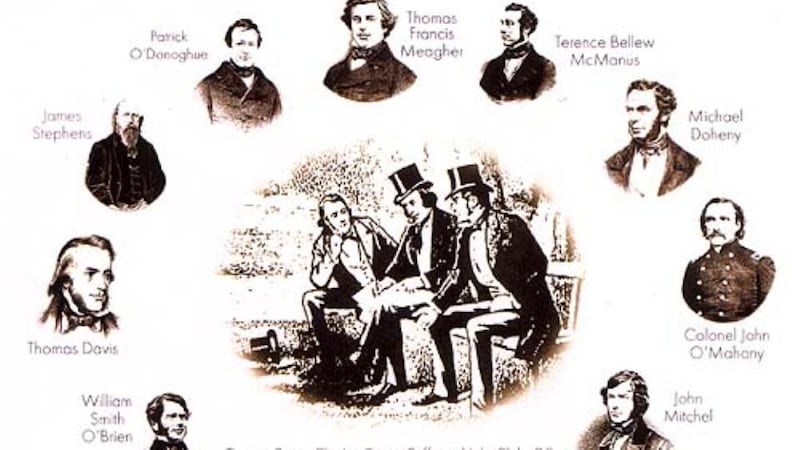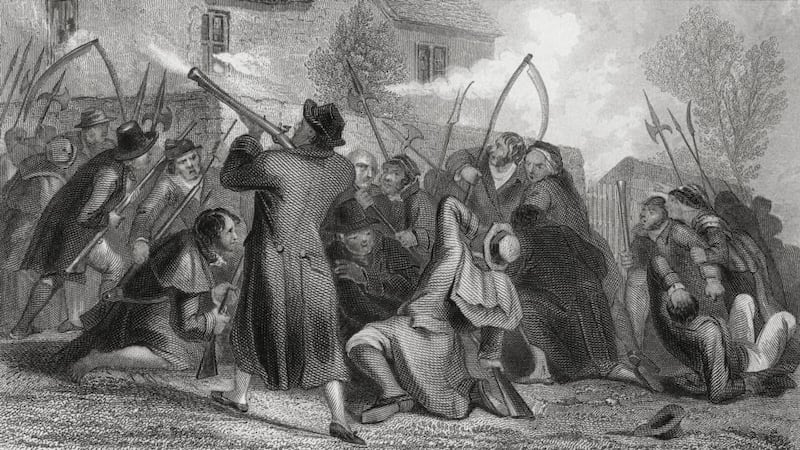In his 1938 poem The Man and the Echo, WB Yeats wondered “Did that play of mine send out / Certain men the English shot?” Evidence from sources such as the witness statements in the Bureau of Military History, in which republican activists recall the various influences that set them on the path to armed rebellion, would suggest that Yeats need not have worried too much and that his plays were not a major influence on those involved in the Irish revolution of 1916-21.
Instead the influences most commonly cited by these activists were the rousing ballads and books written by nineteenth-century nationalists such as Thomas Davis, John Mitchel and AM Sullivan. Works such as The Spirit of the Nation (1843), Mitchel’s Jail Journal (1854) and History of Ireland (1868), and Sullivan’s Story of Ireland (1867), struck a chord with many young readers and inspired many young men and women to join nationalist organisations and agitate for greater national independence.
Even Yeats himself was influenced by them. It was largely through reading the writings of Young Ireland in the library of the old Fenian John O’Leary that Yeats became sympathetic to nationalism, and was persuaded for a time to try “to see the world as Davis saw it”. Yeats, though, eventually became disillusioned with their work, dismissing it as shallow and chauvinistic, and railed against the fact that “The Irish people were not educated enough to accept images more profound, more true to human nature, than the schoolboy thoughts of Young Ireland”.


That Yeats should dismiss Young Ireland’s work as being fit only for schoolboys was revealing. From its beginnings in the early 1840s the movement had a strong didactic thrust and its newspaper the Nation proclaimed education as the path to freedom. A central part of this educational programme was the teaching of Irish history – a subject that was deliberately excluded from the curriculum in state-sponsored national schools.
The Young Irelanders argued that since Ireland’s history had mostly been written by its conquerors, her past had been misrepresented as a series of meaningless and chaotic squabbles, and claimed that “The history of Ireland has not yet been written”. Setting the historical record straight was one of their most pressing tasks, and their publishing ventures were dominated by historical works, in both prose and verse. Together with history books that told of Ireland’s brave struggle to maintain her independence against ruthless conquerors, they published stirring national ballads such as A Nation Once Again, The Memory of the Dead and O’Donnell Abú. These were sung and recited in nationalist homes and clubs and passed on from generation to generation, becoming inextricably linked with memories of childhood, youth and home, and central to the way in which many Irish people interpreted their past.
In nationalist circles, constitutional as well as physical force, a thorough knowledge of Irish history came to be seen as an affirmation of one’s patriotism – if one claimed to belong to a separate national family, one should at least know that family’s history. This sense of belonging helped create the “imagined community” of the nation which was bound together by a knowledge of the trials and sacrifices of previous generations. Past failures to throw off the yoke of conquest were seen not as a matter of shame but as evidence of an undying spirit that could never be quenched. In one of his best-known essays Thomas Davis had proclaimed that Ireland was “no sandbank” but “an ancient land, honoured in the archives of civilisation, traceable into antiquity by its piety, its valour and its sufferings”.
Young Ireland told the story of this ancient land, emphasising dramatic and heroic events, praising heroes and condemning villains, celebrating victories and lamenting missed opportunities in an effort to inspire readers rather than just inform them. Influenced by prevailing Victorian notions of martial prowess as an indicator of moral worth, they focused on the deeds of charismatic warrior-leaders such as Hugh O’Neill, Owen Roe O’Neill and Patrick Sarsfield, creating semi-mythic figures whose example gave comfort and courage to later generations.
When domestic history was not suitably heroic, for example during the decades of Protestant oppression and Catholic quiescence that characterised most of the eighteenth century, the Young Irelanders shifted the focus abroad, to the valiant deeds of the Wild Geese, and the victory of France’s Irish Brigade at Fontenoy in the Austrian Netherlands in 1745 was lauded every bit as much as a victory on home soil.
Young Ireland’s books and ballads helped create the notion of history as “unfinished business” and inspired many young men and women with the idea that they too had their part to play in bringing it to a culmination. The ideological underpinning of the separatist movement was provided by journalists and teachers such as Arthur Griffith and Patrick Pearse, who owed an immense debt to the Young Irelanders. In his pamphlet Ghosts, published weeks before the Easter Rising, Pearse invoked Davis and Mitchel as insistent voices from the pantheon of Irish nationalism who cried out to be appeased.
The 1916 Proclamation made clear its debt to Ireland’s history, explicitly invoking “the dead generations from which [Ireland] receives her old tradition of nationhood” in justification of armed action and placing the insurrection in a centuries-long campaign of resistance to conquest. And no sooner was the Rising over than its martyrs took their place in Ireland’s roll of honour and inspired others to take up the cause. Tom Barry, the renowned commander of the IRA’s West Cork Brigade flying column, claimed that he was entirely ignorant of Irish history when he joined the British army during the first World War but, inspired by the actions of the 1916 rebels, his voracious reading of Irish history created the awareness of past sufferings and desire for revenge that drove him to take up arms against the British empire. Barry’s experience was replicated by many others, showing just how important the writing of history can be in the making of history.
[ Young Ireland and the Writing of Irish History is published by UCD PressOpens in new window ]














